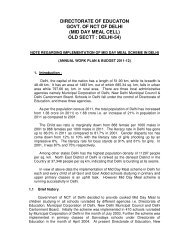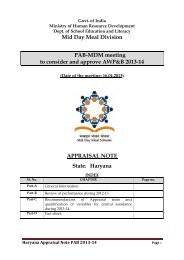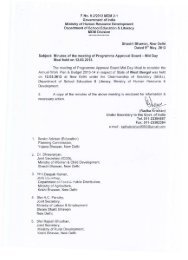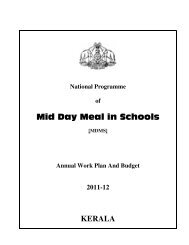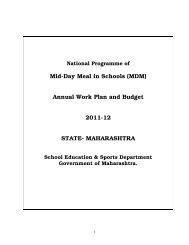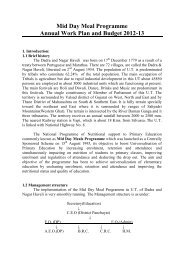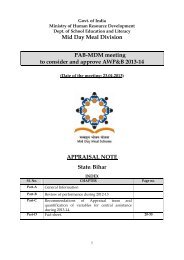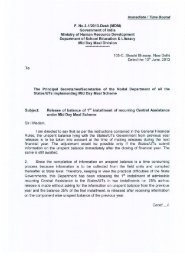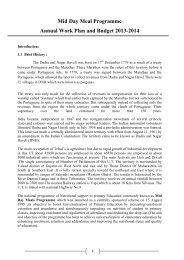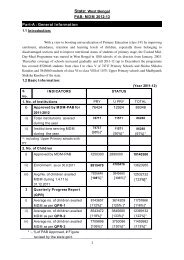First -(14th to 20th Feb 2010) - Mid Day Meal Scheme
First -(14th to 20th Feb 2010) - Mid Day Meal Scheme
First -(14th to 20th Feb 2010) - Mid Day Meal Scheme
You also want an ePaper? Increase the reach of your titles
YUMPU automatically turns print PDFs into web optimized ePapers that Google loves.
The Mission Objectives1. Review the system of fund flow from the State Level <strong>to</strong> School/cookingagency level and the time taken in this process2. Review the management and moni<strong>to</strong>ring system and its performancefrom State <strong>to</strong> school level3. Review the progress of the programme during 2009-10 with respect <strong>to</strong>availability of food grains and funds at school/cooking agency level,quality and regularity in serving the meal in the selected schools anddistricts, transparency in implementation, role of teachers, involvemen<strong>to</strong>f community, convergence with school health programme forsupplementation of micro nutrients and health checkups, etc4. Assess the satisfaction of the children, parents and teachers about theimplementation and impact of the scheme5. Review the maintenance of records at school/cooking agency level6. Review the availability of infrastructure, its adequacy and source offunding7. Suggestions for the implementation of the programme.
BIHARDistricts Selected Gaya NalandaDemographic Profile of the StateBihar is located in the eastern part of the country (between 83° 30' <strong>to</strong> 88°00' longitude). It is an entirely land–locked state, although the outlet <strong>to</strong> thesea through the port of Kolkata is not far away. Bihar lies mid-way betweenthe humid West Bengal in the east and the sub humid Uttar Pradesh in thewest, which provides it with a transitional position in respect of climate,economy and culture. It is bounded by Nepal in the north and by Jharkhandin the south. The Bihar plain is divided in<strong>to</strong> two unequal halves by the riverGanga which flows through the middle from west <strong>to</strong> east.LongitudeLatitudeRural AreaUrban AreaTotal AreaHeight above Sea-LevelNormal Rainfall24° 20' 10" - 27° 31' 15" N83° 19' 50" - 88° 17' 40" E92,257.51 sq. km1,095.49 sq. km94,163.00 sq. km173 Feet(52.73 Meter)1,205 mm
Avg. Number of Rainy <strong>Day</strong>s52.5 <strong>Day</strong>s in a YearSocial and economic indica<strong>to</strong>rs in the State, including literacy rates, healthindica<strong>to</strong>rs (IMR, MMR), sex ratio, poverty ratios, etcIndica<strong>to</strong>rsBiharTotal population (Million) 82.88Rural Population (%) 89.6Birth rate 30Child population (0-4 Years), (Million) 12.0Sex ratio (all) 921Sex ratio (0-6 years) 942Life expectancy at birth: Male 61.4Life expectancy at birth: Female 59.5Infant mortality rate 58Underweight children (below 3 years), (%) 58.4Gross enrollment ratio (6-14 years, %) 80.42Complete immunization (all) Before 24 months), (%) 32.8Maternal mortality rate (MMR) 371Source: Census 2001, NHFS III, DISE 2006-07District - GayaGaya was earlier a part of the ancient Magadh region. Gaya is also theheadquarters of Gaya District. Gaya is 100 kilometers south of Patna, and issituated on the banks of Falgu River. It is a place sanctified by both theHindu and the Buddhist religions. It is surrounded by small rocky hills(Mangala-Gauri, Shringa-Sthan, Ram-Shila and Brahmayoni) by three sidesand the river flowing on the fourth (western) side.
District - NalandaNalanda district is a part of the Patna division. Bihar Sharif <strong>to</strong>wn is theadministrative headquarters for this district. Important places in Nalandaare the Nalanda University, Rajgir, Swarna Gufa, Riddhakuta Parvat andVishwa Shanti Stupa.Facts & FiguresThe <strong>to</strong>atl area of the district is 2367 sqkm and as per Census 2001 thepopulation is 23,68,327 (Males-12,36,467 and Females -11,31,860). Thepopulation density is 1006 per Sqkm, Sex Ratio is 915 and Literacy Rate is53.64%,Blocks: There are 20 blocks. Hilsa, Karaiparsurai, Akangarsarai,Parwalpur, Islampur, Rajgir, Silao, Ben, Giriyak, Katarisarai, Asthawan,Bind, Sarmera, Harnaut, Biharsharif, Rahui, Chandi, Tharthari, Noorsarai,NagarnausaDistrict Nalanda was selected by the State of Bihar on thebasis of low performance in financial year 2008-09SNo.SchoolsChildren as perAWP&B 2008-09No of childrenactually availedMDM during2009-10Difference1. Primary 303178 146194 1569842. Upper Primary School 124368 96817 27551
Findings and ObservationsThis section outlines the team’s main findings concerning all the seven objectives, noting thestatus, concerns and recommendations. It also captures the suggestions made by thegovernment officials and others <strong>to</strong> make MDM distribution more efficient.1. Fund Flow from State Level <strong>to</strong> School Level and time taken in thisprocessStatusThe process followed for fund flow in the state is the state MDM Direc<strong>to</strong>rgets the approval from the cabinet for the withdrawal of fund under cookingcost, transportation cost, kitchen shed, kitchen device and Management,Moni<strong>to</strong>ring and Evaluation from treasury and then the society transfersfunds <strong>to</strong> district through a draft in favour of MDM (name of district). Eachdistrict has a separate account for MDM. The district then sends the fund <strong>to</strong>school through A/c payee cheque in favour of VSS (name of the school) andin a few districts (Nalanda) the fund is electronically transferred <strong>to</strong> schools.The state MDM Cell has issued a directive <strong>to</strong> all districts <strong>to</strong> open separatebank accounts for MDM at district and school level <strong>to</strong> smoothen the flow offund timely <strong>to</strong> all schools. (Letter no. 533 dated 14.10.2008 and letter no.8/MDMC-65/2009-392 dated 28.07.2009)The status of fund received by the state is as follow-Year of Fund Received Source of Fund AmountPresent Status(Rs in Lakh)2008-09 GOI 40981.185 10.09.2008 /16.12.2008 /23.03.2009GOB 14342.282009-10As per the available data the time taken for fund <strong>to</strong> flow from state <strong>to</strong> districtand district <strong>to</strong> school is approximately between 60-78 days.Year 2009-10Compone Date on Date on Date on Date on Date on Date onnts which GOI which which the MDM which whichletter state gets statereceived draft was districtreceived cabinet received the the draft issued <strong>to</strong> transferby state approval draft fromdistrict fund <strong>to</strong>treasuryschoolsCooking 26.05.09 28.07.09 17.08.09 15.09.09 03.10.09 14.10.09CostKitchen NIL NIL NIL NIL NIL NILshadeKitchen 16.09.09 18.02.10 In processDevicesMME 26.05.09 28.07.09 17.08.09 15.09.09 03.10.09 14.10.09Transportation26.05.09 04.09.09 30.10.09 19.11.09 Dec 2009
Cooking Cost: In the district of Gaya <strong>to</strong>tal amount released was Rs 123446000 and utilization as on 31.12.09 is Rs.82426383 (66.77%).In Nalanda the fund released was Rs. 43018000 for Primary and Rs.22923000 for Upper Primary and expenditure as on 31.12.09 isRs.72593820 for Primary and Rs. 20609174 for Upper Primary. Sincedistrict has unspent funds of 2008-09 so the expenditure is more than thefund released by state.Transportation cost: In Nalanda Rs.5537000 was released <strong>to</strong> the schoolsand <strong>to</strong>tal expenditure as on 31.12.09 is Rs. Rs.3750173. Further, it was alsomentioned by the district official that 75% amount of transportation hasbeen released and remaining 25% amount will be released after taking theUCs. Records related transportation cost for Gaya district was not available.Kitchen Shed: The <strong>to</strong>tal fund received from state for Gaya was Rs.91740000 and district has released Rs.28080000 <strong>to</strong> the schools, theexpenditure is only 30.60%.The Nalanda districts have received Rs. 66660000 and the same has beenreleased <strong>to</strong> the schools and the expenditure as on 31.2.09 is Rs. 30540000.Name of thedistrictNo. of unitssanctionedNo. of unitscompletedNo. of unitsunderprogressNo. of unitsyet <strong>to</strong> startGaya 3016 583 316 2117Nalanda 1669 1132 396 141MME: The funds under MME were used <strong>to</strong> purchase weighing machine in2008-09. As informed by Direc<strong>to</strong>r MDM in 2009-10 100% MME funds willbe transferred <strong>to</strong> school for painting of MDM information chart, and menuchart in schools. In Gaya the <strong>to</strong>tal release from state was Rs. 2787606.However, Rs 962045 has been released and utilized by the schools (34.51%).In Nalanda <strong>to</strong>tal release <strong>to</strong> district has been Rs.1438750 and theexpenditure as on 31.12.09 is Rs. 882205 (61.73%).Kitchen Devices: The <strong>to</strong>tal fund released from state till 31 December 2009<strong>to</strong> district of Gaya was Rs. 15080000 <strong>to</strong> procure 3016 units of kitchendevice. In Nalanda the <strong>to</strong>tal fund released till 31 December 2009 is Rs10655000 <strong>to</strong> procure <strong>to</strong>tal 2131 units. As stated by district the utilization ofthe funds for kitchen devices was 100%.During field visit it was found that Government <strong>Mid</strong>dle School Pathari (GayaDistrict) was unable <strong>to</strong> provide MDM during August, September and Oc<strong>to</strong>ber2009 because of no funds <strong>to</strong>wards cooking cost was available with theschool even though food grains was available. However pass book showedavailability of funds (more than 6 lakhs) in the bank account but since MDMfund was send <strong>to</strong> SSA account the teacher was not maintaining separateupdate about the heads under which fund was available.
In Nalanda district the availability of funds was satisfac<strong>to</strong>ry at school level.On investigating it was observed that the district had ensured electronictransfer of funds since last 6 months and it was evident when the team sawthe pass books in Government <strong>Mid</strong>dle School, Rajgir and Uthkramith <strong>Mid</strong>dleSchool, Naya Pokhar (Nalanda District)The MDM was disrupted in first week of <strong>Feb</strong>ruary <strong>2010</strong> in the MadhyamicVidyalaya Attri, Gaya due <strong>to</strong> the unavailability of cooking cost as perrecords. However the mid day meal was being served on the day of visit.Observations The systems of fund flow are apparently varied in the districts as isseen from the two districts visited. As per records sufficient funds was available in all schools in last 6months Due <strong>to</strong> transfer of funds in VSS/Adhoc committee account,confusion prevails regarding availability of fund. (GMS Pathari,Gaya) State has reportedly taken effective steps <strong>to</strong> regularise the fundflow but close moni<strong>to</strong>ring of fund flow is required <strong>to</strong> streamline thesystem across the State The expenditure of fund is quite low in both the districts MME funds as stated by state officials is utilized for payment ofdistrict and block personnel’s honorarium and office maintenance The one time fund for purchasing kitchen device was found <strong>to</strong> beless. During the visit few teachers they suggested that it should beon the basis of enrollment and not a lump sum one time amount.SuggestionsThe system of fund flow was found <strong>to</strong> be time consuming and in district ofGaya there was gap in availability of fund and grains at a particular time infew schools. The team recommends that each school should open separate bankaccounts at the earliest, though the state head quarters has alreadyissued instructions for same but needs <strong>to</strong> be implemented in wordand spirit. State needs <strong>to</strong> ensure that electronic banks transfers are the mode oftransfer from state <strong>to</strong> district and <strong>to</strong> school across the state, againstate has issued instruction for same but follow up is needed. Expenditure percentage needs <strong>to</strong> increase <strong>to</strong> ensure universalisationof MDM.There is urgent need <strong>to</strong> increase the MME funds <strong>to</strong> ensure bettermoni<strong>to</strong>ring and strengthening the existing structure. The kitchen devices grant of Rs. 5,000 is actually less in terms ofutensils <strong>to</strong> be purchased in schools where enrolment is high (GMSMaghra-more than 1000 student). It needs <strong>to</strong> be revised as on thebasis of enrolment in schools.
2. Flow of Food grains from State Level <strong>to</strong> School Level and time takenin this processStatusThe Central Government allocates food grains on the basis of number ofchildren approved by PAB. In the financial Year 2008-09 the <strong>to</strong>tal lifting bythe state was 132297.71 MTs. However in the financial year 2009-10 up <strong>to</strong>third quarter the <strong>to</strong>tal lifting is 150983.523 MTs (82% of <strong>to</strong>tal allocation).The food grains are allotted <strong>to</strong> the Districts by Govt. of India, based on theenrolment. It is then sub-allotted by the District Magistrate <strong>to</strong> the blocks.On receiving the information on sub-allotment, the State Food Corporation(SFC) lifts the food grains from the FCI godowns.Till January 2008 the food grains were lifted from SFC godowns by the PDSDealers who then supplied them <strong>to</strong> the Schools. This system led <strong>to</strong> delay indistribution of food grains <strong>to</strong> schools, hence in order <strong>to</strong> make thedistribution system more efficient the state government decided <strong>to</strong> get thefood grains lifted by the Block Education Extension Officers instead of thePDS dealers <strong>to</strong> ensure timely lifting and adequacy of the quantity of the foodgrains at school level. The BEEO then needs <strong>to</strong> hire a contrac<strong>to</strong>r (Samvedak)who receives Rs. 40/- per quintal as transportation cost. The Rs. 35/- perquintal, is paid <strong>to</strong> SFCIn Nalanda <strong>to</strong>tal food grains allocated <strong>to</strong> Primary and Upper Primary is3209.83 MTs and 2676.99 MTs. of have been respectively. However theutilization of food grains as on 31.12.09 are 2282.21 MTs and 1789.21 MTsin Primary and Upper Primary respectively.An amount of 5886.81 MTs of food grains have been allocated and 5886.81MTs have been released and an amount of 4071.43 MTs of food grains hasbeen utilized (percentage utilization - 69%)In Government <strong>Mid</strong>dle School, Manpura (Gaya District) due <strong>to</strong> unavailabilityof food grains the meal was not served for more than one year ( May 2008 <strong>to</strong>July 2009). However the school had funds and received more funds inOc<strong>to</strong>ber 2008. Presently meal is served regularly as it is being served byNGO since July 2009.In Gaya the records showed quite gaps with respect <strong>to</strong> availability of foodgrains in schools in the last nine months, but the situation had improvedsubstantially since December 2009. On probing the team found the reasonbehind the improvement was the District Magistrate order <strong>to</strong> SFC <strong>to</strong> issueSIO on 19th day of each month <strong>to</strong> BEEOs, who in turn as per allotment liftsfood grains directly from FCI.The food grains are then distributed <strong>to</strong> respective schools through thecontrac<strong>to</strong>r identified at the block level. It was evident that the food grain was
District has no authority for extension of food grains allocatedAs reported by SDEO, Gaya that the weighing machines available at thegodown of FCI was not functioning and it led <strong>to</strong> delay in lifting of grains inthe month of September and Oc<strong>to</strong>ber 2009Few suggestion made by DM, Gaya – Need <strong>to</strong> impoverish the infrastructure of FCI proportionately at districtlevel looking at the pressure with the increase in amount of grainslifted. Decentralisation of powers at district level so that food grains do notlapse Better readressal system for quality checkIt was observed that the quantity of rice served was more than theprescribed norms and on question the head master of Rajakiya MadhyamikVidyalaya Sillarya (Block-Bodh Gaya) said that if denied the parentscomplain so he prefers serving MDM on less number of days but more inquantity. Interaction with parents in schools revealed that the quantity ofMDM served is sufficient but it is not served daily.In both the districts, Nalanda and Gaya the Mission team discovered thatthere has been no inspection of the food grains by the food Inspec<strong>to</strong>rs ofHealth Department at any level.Menu of <strong>Mid</strong>-<strong>Day</strong> <strong>Meal</strong>: All school had a display board where menu for theweek was displayed and it was followed in all schools where team made avisit.Prescribed Menu1 Rice – Vegetables2 Rajma- Rice3 Soyabean – Rice4 Khichari – Chokha5 Kadi-Chawal6 Dal- Pulav7 Chola – chawalIt was observed that menu is prescribed by the state, the state officialsindicated that the district had the option of making local changes but nolocal change of menu was observed in the schools visited by the team(except Madhyamic Vidyalaya, Pathari).There is a nutritional expert at the state level. The direc<strong>to</strong>r MDM briefed thatthat they had plans <strong>to</strong> bring changes in the menu.The MDM served in last nine months was found <strong>to</strong> be regular in schoolswhere MDM is served by NGOs but there were drastic disparity in number of
June 04 02 06 Not servedJuly 25 14 25 Not servedAugust 22 Not served – 22 Not servedno food grainSeptember 14 Not served 13 13Oc<strong>to</strong>ber 17 07 17 16November 16 07 14 14December 18 11 19 14The above tables shows that food was not served for a considerable period (5 months) in NPS Pali,Attri as school being a new school <strong>to</strong>ok time in opening a bankaccount the food served was not very regular in 1 st and 2 nd quarter, however ithas improved in 3 rd quarter of year 2009.In an ideal situation cooking is done on the basis of previous dayattendance of children, but in all the schools where the team made avisit the cooking was found <strong>to</strong> be done on estimate. The cooks werefound <strong>to</strong> be unaware that each day they need <strong>to</strong> cook food on the basisof actual attendance of children.In majority of schools visited the MDM served matched with the attendanceof children but there were difference in few schools.Name ofSchool(Gayadistrict)MadhyaVidyalaya, Suryapura(<strong>Meal</strong>servedby NGO)<strong>Mid</strong>dleSchoolDates Primary Section (I-V) Upper Primary Section (VI-VIII)AttendanceNumber ofchildrenavailed MDM% ofchildrenwho ateMDMAttendanceNumber ofchildrenavailed MDM% ofchildrenwho ateMDM1.2.10 141 60 43 108 50 462.2.10 157 110 70 120 70 583.2.10 144 110 76 114 80 704.2.10 147 115 78 102 96 945.2.10 133 120 90 87 75 866.2.10 127 110 87 102 70 687.2.10 118 102 86 Record not available8.2.10 139 107 77 111 85 779.2.10 107 95 89 110 87 7910.2.10 131 115 88 96 77 8011.2.10 Record not available 82 80 9812.2.10 Holiday Holiday13.2.10 Record not available 96 <strong>Meal</strong> not 0served14.2.10 Record not available 138 <strong>Meal</strong> notserved01.2.10 Record not available Record not available2.2.10 Record not available Record not available
Etwa(<strong>Meal</strong>preparedinschool)3.2.10 Record not available Record not available4.2.10 319 278 87 232 188 815.2.10 306 292 95 206 174 846.2.10 347 248 71 201 166 837.2.10 SUNDAY8.2.10 316 296 94 217 198 919.2.10 350 312 89 241 200 8310.2.10 332 319 96 238 212 89The table above shows that on average 76% children receive MDM on aparticular day.The table below shows the number of days MDM was served in differentschools during April–December 2009Name of SchoolMadhya VidyalayaSuryapura BodhgayaUtkramit KanyaMadhya VidyalayaMaiyar, NalandaRajakia MadhyaVidyalaya Kul SilavNalandaMadhya Vidyalya RajgirNalandaNo of days schoolwas openedNo of days MDMwas servedDifference indays178 148 30171 135 36171 135 36170 127 43The above table shows that number of days MDM served in school is muchbelow the approved number of days.Observations Quality of food served was satisfac<strong>to</strong>ry in appearance and taste. In GMS Barev, GMS Pathari Attri and GPS Kanya, Attri (Gaya District)the quality of rice served was below FAQ standards. Quantity of rice served was more than the prescribed norms Menu was followed in all schools The MDM served in last nine months was found <strong>to</strong> be regular inschools where MDM is served by NGOs Drastic disparity in number of days was found in schools where mealserved by Adhoc Committee. It varied from 4 days <strong>to</strong> 22 days in different months. On an average the MDM served was found <strong>to</strong> be less than theprescribed number of days There was a gap of a day or two in no. of working days and no. of daysMDM was served in all schools, but the gap was quite wide in GMSSuryapura and GMS Itawa (Gaya)
Further, in the State of Bihar due <strong>to</strong> high enrolment and if all childrenattend school in a given day, take meal, chaotic condition may prevailin the schoolsSuggestions There is a need <strong>to</strong> enhance the number of days MDM served in school<strong>to</strong> at least 200 days in a year The quality of foods served by NGO needs <strong>to</strong> be moni<strong>to</strong>red duringsummers as it has chances of getting spoilt. There is need <strong>to</strong> review the menu and provide flexibility <strong>to</strong> schools forlocal variance depending on the availability of local green vegetablesand food habit. The Review Mission Members suggested that the state levelnutritionist <strong>to</strong> be consulted both while preparing the menu and alsoinspection of the quality of the mid day meal served at frequentintervals. Concept of Kitchen garden in schools <strong>to</strong> be promoted4. Review the management and moni<strong>to</strong>ring system and its performancefrom State <strong>to</strong> school levelStatusAs per notification issued by the GOA, Bihar has a Steering cum Moni<strong>to</strong>ringCommittees at State and district levels. The Mission was informed that thecommittees both at state and district level meet regularly.The team found that there is a state level MDM society with personnel at alllevel for management and moni<strong>to</strong>ring the programme (Annexure III). StateGovernment of Bihar have recruited District Resource Persons and BlockResource Persons on contractual basis who are given the target <strong>to</strong> moni<strong>to</strong>r50/100 schools in a month. And it was actually observed at the field level asthe signatures of the persons were seen in the registers at schools.At district level there is office set up with basic facilities like computer, faxand phone for moni<strong>to</strong>ring mid day meal on regular basis.State calls regular monthly meeting of SDEO and DRPs <strong>to</strong> review theprogramme, similarly district carries out monthly review of BRPs. Howeveron discussion it was shared by MDM that during the monthly meeting datais collected from all districts.Direc<strong>to</strong>r MDM GOB shared that a separate website of MDM Society has beendeveloped recently for online monthly reporting, the website ismdmsbihar.org.in. The other moni<strong>to</strong>ring structure is the BRPs and SDEOEducation they are directed <strong>to</strong> send the achievements on weekly basisthrough a sms <strong>to</strong> the above mentioned website and report online also.
However the moni<strong>to</strong>ring structure was found <strong>to</strong> be weak as there wasoverlap of task assigned <strong>to</strong> District and Block Resource Person as the rolesand duties are not defined well.The team interacted with the BRPs and DRPs in Gaya on their role andduties. The dairies and notebooks where evidence <strong>to</strong> show that the BRPswere making field visits.Observations Inspection Registers were not found in most of the schools Honorarium paid <strong>to</strong> DRP and BRP is Rs 3500/-, it needs <strong>to</strong> be revised<strong>to</strong> facilitate better moni<strong>to</strong>ring. Lack of awareness among district and block personnel on the normsand guidelines of MDM and their roles Variety of formats available at district levelSuggestions Inspection Rosters are <strong>to</strong> be prepared for every school <strong>to</strong> ensure thatall Primary and Upper Primary Schools and EGS/AIE centers areinspected at least once every three months. Capacity development plan for BRP & DRP Duties and responsibilities of all DRP and BRP needs <strong>to</strong> be morespecific. Setting up of a grievance reddressal system Moni<strong>to</strong>ring system needs <strong>to</strong> be strengthen by providing extra facility5. Assess the satisfaction of the children, parents and teachers aboutthe implementation and impact of the schemeStatusAs a school based programme the MDM initiative must be able <strong>to</strong> draw widecommunity participation for transparency in management of the programmeand ensuring quality of the food provided. This area would require activationof the SMCs and motivation of the community including parents.VSS in Bihar completed its tenure and has been defunct since last 2-3years. Principle Secretary HRD shared election of the Samiti was notexpected <strong>to</strong> happen before 2011. Hence the fact remains that there wasvirtually no involvement of community in any of the schools visited.Community involvement was found <strong>to</strong> missing in all schools.As per the MDM Guidelines the School managements should also beencouraged <strong>to</strong> draw on the support of the community Gram Panchayats forarranging community members <strong>to</strong>o regularly, on a rotation basis, help theschool management in ensuring efficient cooking serving and cleaningoperations.The involvement of teachers and community members in ensuring thatchildren eat <strong>to</strong>gether in a spirit of camaraderie and develop sensitivity <strong>to</strong>
their peers with different abilities by offering them precedence and instillingvalues of equality and cooperation would be very valuable support <strong>to</strong> theimplementation of the programme.VSS of schools need <strong>to</strong> keep account of food grains received and utilized costincurred for cooking etc., by maintaining daily attendance/records, etc butsince there is no VSS this work also falls on the shoulder of teacher and itaffects the quality of teaching.The cooks and helpers are engaged by the VSS / Adhoc Committee of theschools. Cooks were found in place in all the schools visited by the teamwhere MDM was being served on the day of visit except schools where MDMwas served by NGO. They were paid a daily wage rate but there wereinstances of lump sum payment. But, most were paying as per the presentnorms prescribed in the scheme. The monthly compensation of the cooksranged from Rs 50/- a day <strong>to</strong> Rs 90/- a day.There was 100% involvement of teachers and student of higher class inschools while MDM was served. Actually in all the schools visited it wasfound that the study was disturbed for more than two hours as theteachers and students were involved in MDM. In all schools there wasscarcity of space <strong>to</strong> sit and eat. The objective of not involving teachers<strong>to</strong> ensure regular studies has failed in all schools visited.All the records related <strong>to</strong> the implementation of MDM in schools aremaintained by the Head Teacher (HT) of the school. The HT also makes thepurchase of items for providing the hot cooked meals, either on a daily orweekly basis through the local vendors.In Madhya Vidyalaya, Maghra Block of Nalanda District the enrolment ofstudents is 1413 and the entire students take MDM. There are 8 teachersand it is really difficult for the teachers <strong>to</strong> carry out MDM day <strong>to</strong> dayactivities with teaching activities also.The responsibilities were generally not found <strong>to</strong> be shared with otherteachers, cooks or VSS members. For obvious reasons the MDM hasamounted <strong>to</strong> added work load for the Head teacher.In Government Primary School Atri (Boys), Urdu Prathamic VidyalayaPanhessa, Silav Nalanda and Government <strong>Mid</strong>dle School, Pathari Gayathe community expressed unhappiness and anger on food not beingserved regularly and also complained about food grains being sold outin market. However there was no empirical evidence found <strong>to</strong> certifythis.All the children who comes <strong>to</strong> school in Bihar takes <strong>Mid</strong> day meal. In theschools visited the members of the Joint Review Mission felt the PTR wasvery high in all schools and so was SCR. Hence the teachers areoverburdened with the teaching and MDM work.
As per the MDM Guidelines, During the visit of the team it was observedthat except one school the rest 15 schools where not displaying informationunder RTI act on the quantity of the food grains received, date of receiving ,quantity of food grains utilized, other ingredients purchased, number ofchildren given MDM.Observations 100% involvement of teachers and student of higher class in MDMdistribution Schools have adhoc committee as VSS completed its tenure Community involvement was found <strong>to</strong> be missing in all schools The attitude of teachers and government officials needs <strong>to</strong> be moresensitive <strong>to</strong>wards community needs Lack of awareness among community on providing support <strong>to</strong>teachers in distribution of MDM It is interesting <strong>to</strong> note that community is neither organised nortrained <strong>to</strong> participate in such a programme. The parents were poor and they were found <strong>to</strong> be interested only intheir own children and have no sense of commitment and involvementSuggestions The cooks and helpers of the schools needs <strong>to</strong> be oriented on the bestmethods of cooking in less time and less wastage of food grains Plans for community awareness <strong>to</strong> be designed <strong>to</strong> ensure bettercommunity participation The involvement of the teachers can be minimised if these local cooksare empowered enough <strong>to</strong> lend hands in purchasing vegetables andother condiments required for daily MDM preparation. So, thatteacher can actually concentrate on teaching learning activities.6. Convergence with school health programme for supplementation ofmicro nutrients and health check upsStatusDirec<strong>to</strong>r MDM shared that state level steering committee has been formedfor School Health Programme. Similarly District level School HealthProgramme Committee has been formed under the chairman ship of DM.State guideline has been circulated <strong>to</strong> all districts. Presently students healthcheck up was started in 7 districts. The HRD is coordinating and healthdepartment is providing funds for Health Card and identifying NGOs forhealth check up at district level. Deworming tablets, IFA tablets are beingprovided in few districts during Health check up camps.Interestingly height and weight chart was painted on the walls of schoolsvisited irrespective of the location (In Government <strong>Mid</strong>dle School Sillarya itwas painted on the wall of a classroom which was used as s<strong>to</strong>re of MDM andwas kept locked).
Weighing machine and Height Measuring chart was available in all schoolsbut in Gaya there was no empirical evidence <strong>to</strong> show it was used regularlyas the weighing was still in a pack.District Magistrate informed the team that School Health Programme hasbeen launched recently in 4 blocks of Gaya district and none of the blockvisited by team was in the list of four.Children were found washing hands in all schools and were aware about theimportance of hand washing. However availability of soap was found only infew schools like GMS Surya pura and GMS Sillarya.Observations Interestingly height and weight chart was painted on the walls ofschools visited irrespective of the location Weighing machine and Height Measuring chart was available in allschools In Nalanda each school maintain a height-weight register which wasupdated every month School Health Programme was initiated in Gaya but not in the blocksvisited by team In Nalanda School Health Programme is yet <strong>to</strong> startSuggestions Team recommends that in order <strong>to</strong> promote hygiene hand washingwith soap before mid day meal should be made manda<strong>to</strong>ry in allschools. School Health Programme <strong>to</strong> be initiated in all schools Availability of soap for hand washing from MME funds7. Review the maintenance of records at school/cooking agency levelThe state has developed formats <strong>to</strong> capture data at all levels. Themaintenance of records was satisfac<strong>to</strong>ry in majority of the schools visited.All schools maintained separate register for primary and upper primary. Theregister was updated in all schools. The register maintained at school wasutilization register, cash register, payment register and complainreaddressal register.The format available at district level has fields <strong>to</strong> record block wise allotmentand availability of funds and food grains. It also captures number of schoolswhere MDM is not served and percentages of schools were MDM is served.8. Review the availability of infrastructure, its adequacy and source offundingStatus
Overall the schools in Bihar are colourful and bright in appearance butcleanliness and sanitation was an issue in majority of schools. All schoolhave received funds for kitchen shade and construction has happened in allschools except in GMS Suryapura where the roof was not in place. Therewas no kitchen shade in GMS Sillarya and GMS Manpura as there wasscarcity of landGovernment Primary School, Atri (Girls) had no hand pump and water formid day meal was fetched from the water source of nearby school and itcreates difficulty for the children and cook.Kitchen shade was not used as s<strong>to</strong>rage room in any schools. All schools hadpurchased approximately 100 plates for children and so MDM was served inshifts.Observations All schools had good building except GMS Manpura, Gaya (school runin double shift) and NPS Pali, Gaya Double unit <strong>to</strong>ilet was available in all schools but its maintenance waspoor. Water facility was available in all schools except GPS Kanya, AttriGaya and NPS Pali, Gaya Hand washing facility was not available in 50% of schools 60% schools had boundary walls Kitchen shade was in all schools except GMS Suryapura (underconstruction), GMS Sillarya (fund received) and NPS Pali All schools had cooking utensils and utensil <strong>to</strong> serve Each school had approx. 100 plates for children <strong>to</strong> eat (eatinghappens in shifts)Suggestions Availability of drinking water in all schools Plan for maintenance of <strong>to</strong>ilet and water points Creating awareness about hygiene and cleanliness Availability of soap for hand washing in all schools9. Suggestions from State and District Officials Increase in the MME funds so that better moni<strong>to</strong>ring system can beestablished Allocation of revised unit cost for kitchen shade as Rs 60,000 is quitelow hence 30,000 kitchen sheds yet <strong>to</strong> be completed in Bihar Provision of funds under kitchen device <strong>to</strong> purchase plates and spoonfor children. The cost on basis of child as a unit and not school maybe considered. FCI <strong>to</strong> stamp the sacs with MDM logo or provide different colour bags<strong>to</strong> maintain the quality of rice supplied.Annexure I
Officers Met during the Review MissionState level1. Mr Anjani Kumar Singh, Principle Secretary, HRD, GOB2. Mr Gurminder Singh, Consultant- MDM3. Mr Rajesh Kumar, Nutritionist-MDM GOB4. Md Mustaba, Asst Programme Coordina<strong>to</strong>r-MDM5. Naresh Kumar Singh Asst Programme Coordina<strong>to</strong>r-MDMGaya District:-1. Shri Sanjay Kumar Singh, District Magistrate,Gaya2. Shri Kartikeyan, Sahayak Samaharta (Prashishu IAS)3. Shri Ranjeet Singh, Zila Shiksha Adhikshak4. Dr. K K Singh, Civil surgeon.5. Shri Pawan Kumar, Zila karyakram Prabandhak, Zila Swathya committee.6. Dr. OmPrakash,-----Gaya7. Shri Nirmal Kumar Rai, SFC,Gaya.Nalanda District:-1. Shri. Sanjay Aggrawal, District Magistrate Nalanda,2. Shri Nayan Ranjan Verma, DSE, Nalanda3. Shri Pramod Kumar Pathak ,District Manager, SFC4. Shri Surendrea Kumar ,SDEO, cum MDM Incharge Nalanda5. Shri. Usman Mian, BEO Rajgir,6. Indradev Paswan, BEO Silao,7. Shri. Mahesh Prasad, District Coordina<strong>to</strong>r,8. Smt. Simple Kumari, BRP, Rajgir,9. Shri Pradip Kumar,BRP, Silao,10. Smt. Archan Kumari, DRP.
Schools Visited in Gaya1. Government Madhya Vidyalaya, Suryapura (Block -Bodh Gaya)2. Rajakiya Madhyamik Vidyalaya Sillarya (Block-Bodh Gaya).3. <strong>Mid</strong>dle School Etwa (Block-Mohanpur)4. Rajakia Madhya Vidyalaya Manpur Adda(Block-Manpura)5. Madhya Vidyalaya, Barev (Block-Manpura)6. Madhya Vidyalaya, Pathari (Block-Attri)7. Kanya Prathamic Vidyalaya Attri (Block-Attri)8. Rajakia Prathamic Vidyalaya Tetua (Block-Attri)9. Prathamic Vidyalaya, Pali (Block-Atri)Annexure IISchools Visited in Nalanda1. Government Madhya Vidyalaya, Rajgir (Block -Rajgir)2. Utkramik Prathmik Vidyalaya Naya Pokhar (Block- Rajgir).3. Utkramik <strong>Mid</strong>dle School (Kanya) Mayaar (Block-Mayaar)4. Rajakia Madhya Vidyalaya Cool (Block-Nalanda)5. Rajakia Madhya Vidyalaya, Maghra (Block- Biharsharif)6. Urdu Primary Vidyalaya, Silao (Block- Silao)7. Ekta Sakti Foundation, Chandi
Annexure IIIManagement SystemDepartment of Human Resource Development↓Direc<strong>to</strong>r MDM (IAS)↓Deputy Direc<strong>to</strong>r↓District Superintendent of Education/ Sub- Divisional Education Officer/ Range EducationOfficer/↓Block Education Extension Officer↓Head Master-----------------------------------------------Fund Flow ChartGovernment of India↓Government of Bihar↓Bihar Rajya Madhyahan Bhojan Yojana Samit↓District officer (MDM in charge)↓School------------------------------------------------FoodgrainGovernment of India↓Government of Bihar/ Food cooperation of India (FCI)↓Bihar Rajya Madhyahan Bhojan Yojana Samiti/ State Food Cooperation (SFC)↓District officer (MDM in charge)/SFC↓Lifting by BEEO/Contrac<strong>to</strong>r↓School---------------------------------------------------Moni<strong>to</strong>ringState level Steering-cum-Moni<strong>to</strong>ring Committee↓District level steering-cum-Moni<strong>to</strong>ring Committee↓Block level steering-cum-Moni<strong>to</strong>ring Committee↓Vidyalya Shiksha Samiti (VSS)
The draft report was read, reviewed and agreed by the Review Mission Team--------------------------------------------------------------------------Smt Rita Chatterjee, (Direc<strong>to</strong>r-MDM, MHRD)-------------------------------------------------------------------------Shri Vipin Kumar (Direc<strong>to</strong>r-MDM, GOB)------------------------------------------------------------------------Dr Anindita Shukla, Consultant (Food & Nutrition-MDM, NSG)--------------------------------------------------------------------------Ms Shweta Sandilya (Education Specialist, UNICEF, Bihar)---------------------------------------------------------------------------Shri Rupesh (Secretary, Koshish Charitable Trust, Patna)Place: PatnaDate: 20 <strong>Feb</strong>ruary <strong>2010</strong>


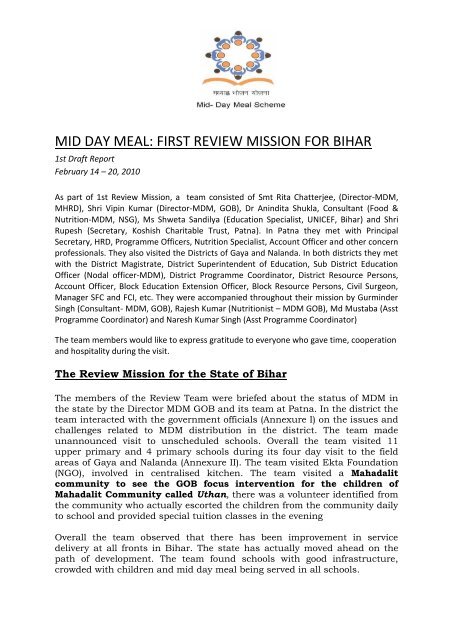
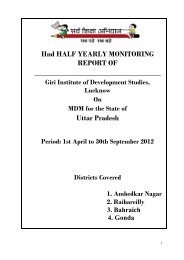
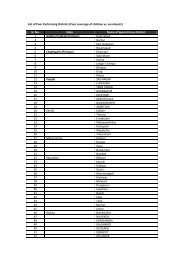
![Na National Programme Of Mid-Day-Meal in Schools [MDMS]tional ...](https://img.yumpu.com/51029020/1/184x260/na-national-programme-of-mid-day-meal-in-schools-mdmstional-.jpg?quality=85)
